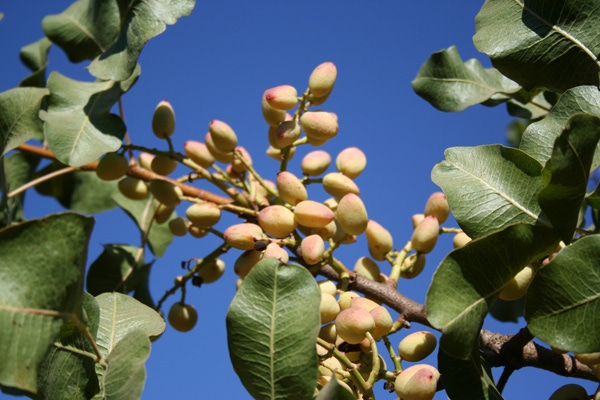March 4, 2016

A pistachio tree requires far more supplemental nitrogen (N) than any other single nutrient to maintain proper health and productivity.
For example, a thousand pounds of mature pistachio nuts, including the hulls, contain about 28 pounds of nitrogen.
However, keeping a tree supplied with the right amount of nitrogen is more complicated than simply replacing the N removed when the nuts are harvested, says Craig Kallsen, reports University of California Cooperative Extension farm advisor for Kern County in his January 2016 Kern Pistachio Notes newsletter.
He points out that fertilizing with N or other required elements don’t feed or fatten up a plant with the nutrients. Instead, the nutrients enable the plant to use the energy in carbohydrate, the food produced by photosynthesis, to maintain the photosynthetic and respiration systems, grow the plant, and produce reproductive structures including pistachio nuts.
Not all N applied as fertilizer to the tree produces the nut crop. Some is directed to growing new leaves and shoots. And some of it never makes its way into the tree.
Soil-applied N may be tied up in organic matter or lost through denitrification by soil-borne organisms. Nitrogen in the soil can also be lost in surface runoff or washed out of the soil profile through leaching, especially if leaching is used to reduce soil salinity levels.
“If we progressively fail to replace fertilizer elements removed at harvest, used in tree growth, and otherwise lost during crop production, then the soil is being depleted and is becoming less productive,” Kallsen explains.
At the same time, the tree may be getting some N from other sources other than fertilizer applications. This can include nitrogen-containing molecules from vehicle exhaust, other human-related activities, and electric storms washed out of the atmosphere in rain.
N in irrigation water can reduce the need for annual N fertilizer requirements on a pound for pound basis, Kallsen adds. Allowing fallen leaves and shredded pruning to decay in the orchard can also provide trees with N.
Another factor complicating N fertilizer needs is the alternate-bearing habit of pistachio trees, he notes. Typically, but not always, a high yielding on-year is followed by a lower-yielding off-year.
So, should a grower increase the amount of N applied during the on-year and reduce during the off-year?
Research suggests that fertilizing the pistachio crop on a two-year basis, as opposed to a single-year basis, may have merit, says Kallsen. In this study, the total N demand of the trees was very similar between the on- and off-years.
During the on-year, 85 percent of the total N uptake went to the nuts. But, the researcher found that 67 percent of the N went to the canopy during the off-year.
“These data suggest that in the off-year the tree is growing the leaf canopy for light capture and associated carbohydrate production and storing N that is utilized for nut production during the on-year,” Kallsen says.
“The application of similar quantities of N during the on and off-years, in combination with maintaining more manageable tree size through pruning, may help mitigate large swings in alternate bearing.”
To reduce N pollution from fertilizer applications, the goal is to apply enough N to produce the maximum crop possible under existing environmental limitations, while minimizing the amount of residual N remaining in the soil after leaf drop in the fall, Kallsen notes.
This is especially important in salty soils where extensive salt leaching will occur during the winter or in areas with high winter and spring rainfall,
“There is no point in providing more fertilizer than is necessary for the crop to maintain optimal light interception, and its eventual conversion into energy by the leaf canopy, per unit of ground area,” he says.
Kallsen recommends testing soil N level in the spring to help estimate how much of the nutrient is available in the soil rooting profile for the upcoming season. Some of this can be counted toward the annual N fertilizer requirement.
If leaf testing in August reveals high N levels, this usually suggests high N storage in the tree plus high residual N levels in the soil.
“Both of these conditions suggest that N fertilization rates can probably be reduced significantly the following year without danger of reducing yields,” says Kallsen.
“Good record keeping can greatly assist the grower in adjusting current N applications based on historical N fertilization, leaf and soil N levels, and crop yields. If post-harvest soil-N levels are increasing year over year, and yields are optimal, N fertilization rates can probably be reduced.
A model for estimating and adjusting in-season N and K fertilization requirements for pistachio is available at http://fruitsandnuts.ucdavis.edu/files/165545.pdf
For more information, contact Kallsen at [email protected].
You May Also Like




